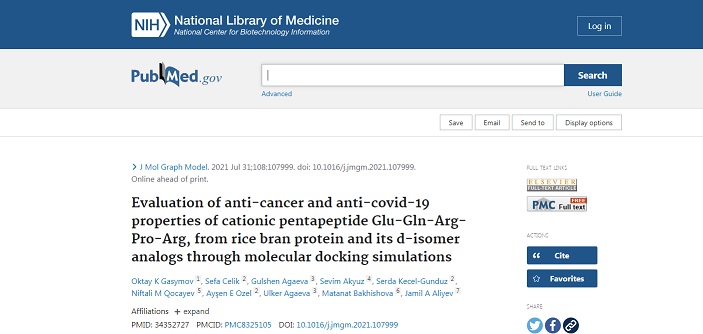Azerbaijani and Turkish scientists have achieved significant results in the fight against COVID-19 and cancer



Recently, extensive research has been conducted on antiviral and anti-cancer peptides in the fight against viruses and cancer. Bioactive peptides are not toxic to the human body; they also have very effective anti-viral and anti-cancer properties.
As a result of joint research under a joint program signed between the Azerbaijan National Academy of Sciences (ANAS) and the Turkish Scientific and Technological Research Council (TÜBİTAK), the possibility of the usage of cationic EQRPR peptide obtained on the basis of hydrolysis of rice bran protein in the fight against cancer and COVID-19 infection and their mechanisms of action have been studied.
As it was reported from ANAS to AZERTAC, the research has been conducted under the leadership of the director of the National Center of Oncology Academic Jamil Aliyev, the corresponding member of ANAS, the director of the Institute of Biophysics Oktay Gasimov, Professor of Baku State University Niftali Gojayev and Professor Sevim Akuyuz from Turkey.
Both theoretical (molecular docking, molecular mechanics) and experimental (Fourier Transform Infrared Spectroscopy, Raman Spectroscopy, Circular Dichroism and Electron Paramagnetic Resonance Spectroscopy) methods have been widely used in complex research. In addition, both point D-isomer changes and complete D-isomer peptides of EQRPR peptide were synthesized and changes in their pharmacological properties were studied.
It should be noted that for the first time scientists of the two countries showed combinations of peptides and their D-isomer analogs with ACE2, SARS-CoV-2 virus S- and Mpro proteins by applying the molecular docking method, as well as possible clinical profiles were determined by calculating the combination constants of the complexes. The applied EQRPR peptide has been shown to be multifunctional.
According to the experts, the peptide can bind to a number of important integrins. It can be widely used in the fight against both SARS-CoV-2 virus infection and cancer.
One of the important results is that the multifunctional peptide can be modulated by carrying out D-isomer changes at different points of the binding property of different proteins. The secondary structure of the EQRPR peptide was calculated by various spectroscopic methods, and the spatial structure was calculated on a theoretical basis. The successful combination of experimental and theoretical results is commendable.
Preliminary studies in lung cancer cells have shown that the EQRPR peptide interacts with the cell membrane. Important results of the project were published in the international Journal of Molecular Graphics and Modelling with a high impact factor (Evaluation of anti-cancer and anti-COVID-19 properties of cationic pentapeptide Glu-Gln-Arg-Pro-Arg, from rice bran protein and its d-isomer analogs through molecular docking).
It was noted that the research of significant clinical and fundamental importance is ongoing.

